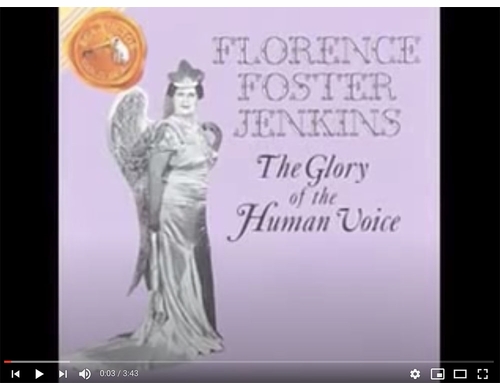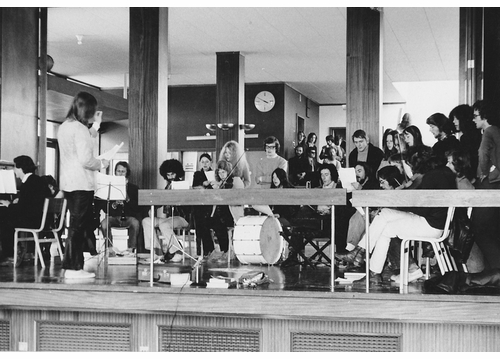| RECENT POSTS DATE 11/1/2024 DATE 10/27/2024 DATE 10/26/2024 DATE 10/24/2024 DATE 10/21/2024 DATE 10/20/2024 DATE 10/17/2024 DATE 10/16/2024 DATE 10/15/2024 DATE 10/14/2024 DATE 10/10/2024 DATE 10/8/2024 DATE 10/6/2024
| | | CORY REYNOLDS | DATE 5/15/2020Compiled by Chris Reeves and Aaron Walker on the occasion of the publication of The World’s Worst: A Guide to the Portsmouth Sinfonia, published by Soberscove Press. Listen to the complete playlist here!
1. Florence Foster Jenkins – “Queen of the Night Aria” (Mozart), The Glory (????) of the Human Voice, RCA, 1962.
The godmother of the Sinfonia. A tone-deaf socialite performing in the 1940s surrounded by a society too polite (or cruel) to tell her she stunk. Foster Jenkins’ vocal rendition of the incredibly difficult “Queen of the Night” aria from Mozart’s “Magic Flute,” is a high point of the few recordings that exist of her unforgettable live performances.
Listen here.
2. Temple City Kazoo Orchestra – “2001 Sprach Kazoostra” (Strauss), Some Kazoos, Rhino, 1978
A kazoo ensemble founded by the heads of the Rhino Records label and featuring a few members of Stevie Wonder’s band. Like the Sinfonia, this ensemble brought to the fore how different classical music can sound when put into the hands (or mouths) of playful musicians (and non-musicians).
Listen here.
3. The Majorca Orchestra – “Venice By Night” (Ezra Read), Live Recording from the Lucy Milton Gallery, London, 1976
The Majorca Orchestra was a spin-off of the Portsmouth Sinfonia, consisting of many of its
members. Rather than play familiar classical music, the MO played originals or works by lesser
known composers such as Ezra Read. This version of Read’s “Venice By Night,” represents their capabilities well: they can’t make it to the end of the piece!
Listen here.
4. Michael Nyman – “The Very Beautiful Blue Danube” (Strauss), Audio Arts Vol. 3, No. 2: Recent English Experimental Music, 1983
Sinfonia member Michael Nyman’s transfiguring the most recognizable passage of Strauss’ original into a maddening withholding of melodic resolution.
Listen here.
5. The Portsmouth Sinfonia – “In the Hall of the Mountain King” (Grieg), The Portsmouth Sinfonia Plays the Popular Classics, Transatlantic, 1974
The Sinfonia barely making their way through Grieg’s popular classic. One of my favorites in that, even as a “definitive version” on record, the ensemble can barely play this one.
Listen here.
6. The Portsmouth Sinfonia – “A Day in the Life” (Lennon/McCartney), 20 Classic Rock Classics, Transatlantic, 1978
From the Sinfonia’s brief foray into playing “contemporary” pop music. A surprisingly moving
tribute to the Beatles through their signature dissonance.
Listen here.
7. The Scratch Orchestra – “Liberty Bell” (Sousa), Live recording ca. 1972
The Sinfonia were born out of the Scratch Orchestra’s own populist idea that music making could involve everyone. Like the Sinfonia, the SO also played “popular classics” they recognized from television shows. Their rendition of Sousa’s “Liberty Bell,” famous for being the title theme to Monty Python’s Flying Circus, is one such example.
Listen here.
8. The Portsmouth Sinfonia, “Classical Muddly,” Self-titled 7-inch single, Island Records, 1981
This single, perhaps the most warped of all the Portsmouth Sinfonia’s releases, is a take on the Royal Philharmonic Orchestra’s smash-hit “Hooked On Classics” medley record. The Sinfonia’s détourned response is a collage of classical melodies cut from their own recordings, sped up, amalgamated, and set to a handclap disco beat. Improbably, "Classical Muddly" worked its way onto the UK Singles Chart before being pulled off the air by the BBC due to an allegation of copyright infringement by the publishers of Richard Strauss.
Listen here.
9. Brian Eno, "Brutal Ardour” (Variation on ‘The Canon in D Major’ by Johann Pachelbel),
Discreet Music, LP, Obscure Records, 1975
The A-side of this record is a now-classic work of early electronic minimalism. This track would
provide a conceptual template for much of Brian Eno’s future experiments in self-generating ambient music. The B-side is only slightly less beguiling to my ear, consisting of three deconstructed variations on 'The Canon in D Major' by Johann Pachelbel, as performed by the Cockpit Ensemble and conducted and co-arranged by Gavin Bryars. Eno was less than enthusiastic about the results, but I have a real fondness for these melancholy chamber pieces.
Listen here.
10. Spike Jones and his City Slickers, “The William Tell Orchestra” (Rossini), Spike Jones Is Murdering the Classics, LP, 1971, RCA
The Sinfonia feel as indebted to Spike Jones; satirist, bandleader, and drummer extraordinaire, as they do the community improvising of Cornelius Cardew and the Scratch Orchestra. This track remains a gem of finely tuned big band comedy chaos, stuffed to the brim with dog barks, a gargling solo, and Doodle Weaver’s nonsense horse race calls.
Listen here.
11. The Portsmouth Sinfonia with Sally Binding, “Piano Concerto in A” (Tchaikovsky),
Hallelujah: Live at the Royal Albert Hall, LP, Transatlantic, 1974
Concert pianist Sally Binding joined the Sinfonia at a packed Royal Albert Hall for their performance of Tchaikovsky’s “Piano Concerto in A.” Captured on this live album, the contrast between Binding’s virtuoso soloing and the hesitant bowing of the Sinfonia string section accompaniment is as moving as it is hilarious.
Listen here.
12. The Promenade Theatre Orchestra, “Ambroise Farman's Memory,” The Orangery, Holland Park, 1, October 1972, Experimental Music Catalogue, 2002
The Promenade Theatre Orchestra was an English quartet founded in 1969. In an ad written by
PTO member and systems composer John White, the group’s sound was described as “restful reedorgans, tinkling toy pianos, soothing psalteries, suave swanee whistles, jolly jaw harps–NO noisy electronics! (Just the job for that lazy Sunday afternoon!)” You can hear some of that in this live recording from 1972, released in 2002 by the invaluable Experimental Music Catalogue.
Listen here.
13. Steve Beresford and Anne Marie Beretta, “Comfortable Gestures,” Dancing The Line, Nato, 1986
A Baleric piece of loungewear post-punk by Steve Beresford, trumpeter in the Sinfonia and
renowned free improviser. I hadn’t heard “Comfortable Gestures” until it was recently rereleased on Music From Memory’s compilation Uneven Paths: Deviant Pop From Europe 1980-1991. A lilting, slow dance earworm with some wonderfully fragile singing from Beresford.
Listen here.
 Soberscove Press
Pbk, 6.75 x 9 in. / 232 pgs / 30 color / 80 b&w. $28.00 free shipping | |
|


